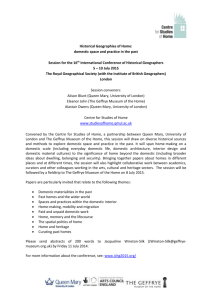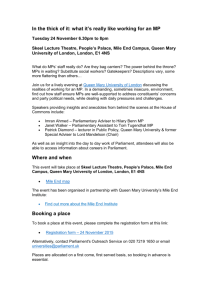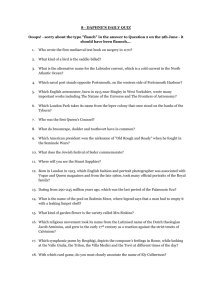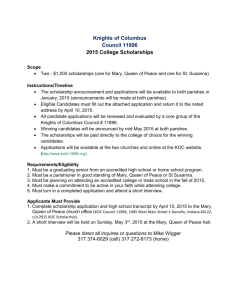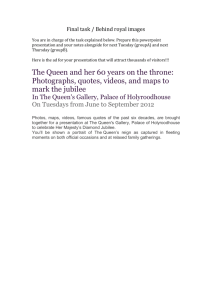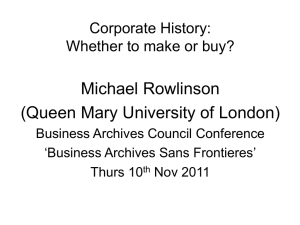Queen Mary From her maiden voyage on May 27, 1936 to her
advertisement
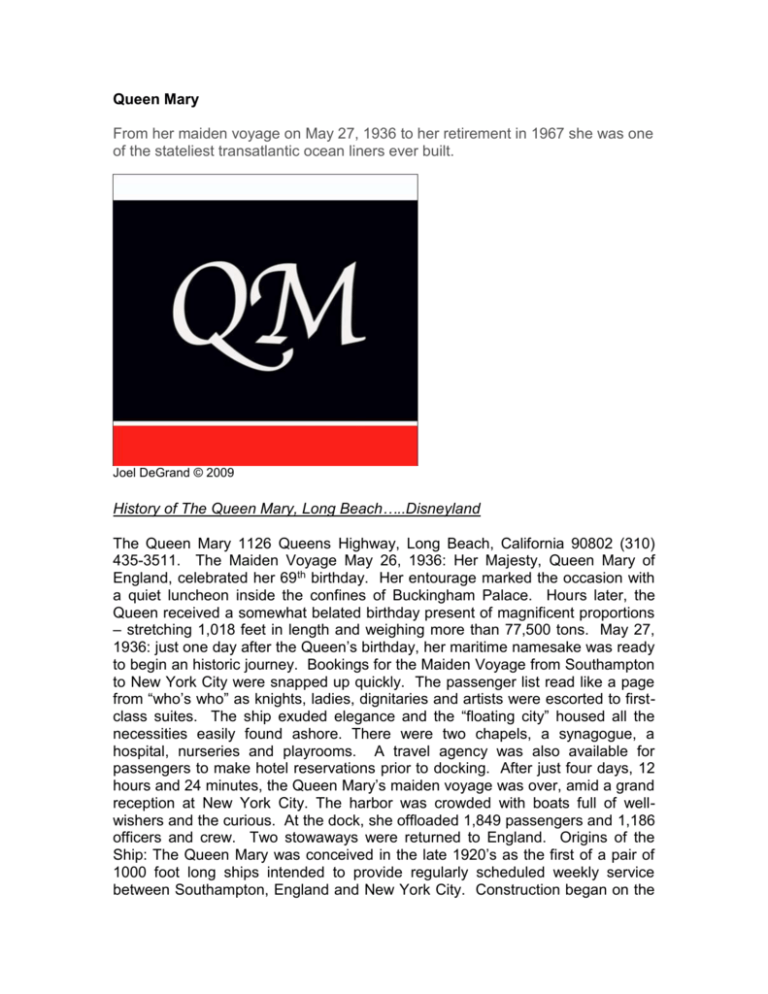
Queen Mary From her maiden voyage on May 27, 1936 to her retirement in 1967 she was one of the stateliest transatlantic ocean liners ever built. Joel DeGrand © 2009 History of The Queen Mary, Long Beach…..Disneyland The Queen Mary 1126 Queens Highway, Long Beach, California 90802 (310) 435-3511. The Maiden Voyage May 26, 1936: Her Majesty, Queen Mary of England, celebrated her 69th birthday. Her entourage marked the occasion with a quiet luncheon inside the confines of Buckingham Palace. Hours later, the Queen received a somewhat belated birthday present of magnificent proportions – stretching 1,018 feet in length and weighing more than 77,500 tons. May 27, 1936: just one day after the Queen’s birthday, her maritime namesake was ready to begin an historic journey. Bookings for the Maiden Voyage from Southampton to New York City were snapped up quickly. The passenger list read like a page from “who’s who” as knights, ladies, dignitaries and artists were escorted to firstclass suites. The ship exuded elegance and the “floating city” housed all the necessities easily found ashore. There were two chapels, a synagogue, a hospital, nurseries and playrooms. A travel agency was also available for passengers to make hotel reservations prior to docking. After just four days, 12 hours and 24 minutes, the Queen Mary’s maiden voyage was over, amid a grand reception at New York City. The harbor was crowded with boats full of wellwishers and the curious. At the dock, she offloaded 1,849 passengers and 1,186 officers and crew. Two stowaways were returned to England. Origins of the Ship: The Queen Mary was conceived in the late 1920’s as the first of a pair of 1000 foot long ships intended to provide regularly scheduled weekly service between Southampton, England and New York City. Construction began on the No. 534 at the John Brown shipyard in Clydebank, Scotland in December 1930. On December 11, 1931 all construction was halted as a result of the worldwide economic crisis known as the Great Depression. Hull No. 534 languished until April 3, 1934 when a government subsidy and the merger of the Cunard and White Star Lines made it possible for work to continue. On September 26, 1934 Hull No. 534 was launched in the presence of His Majesty, King George V by his consort Queen Mary. The Queen surprised and pleased the public by graciously giving her own name to the ship. The heyday of the Queen Mary were the years 1936 to 1939, when she was the flagship of the Cunard White Star Line, soon capturing the prized blue ribbon for a record breaking crossing. Although dubbed the “stateliest ship afloat” by King George V at the time of her launching 1934, life aboard the newest and fastest North Atlantic liner was anything but staid. A brief look at the deck plans provides some insight – there were five bars on the Promenade deck alone. A Queen at War: The Queen Mary was in the mid-Atlantic when Hitler invaded Poland on Friday, August 31, 1939. Loaded with passengers and refugees, she ran a zig-zag course using blackout at night to elude submarines. She arrived safely in New York on Monday, September 4. Converted for use as a troop transport, the Queen Mary spent the next six years transporting over 800,000 troops. During the course of the war, she visited places as far away as Bombay, India, Hong Kong; Rio de Janeiro, Brazil; and Sydney, Australia, British Prime Minister Winston Churchill credited the ship with shortening the war by as much as a year. After the war she transported troops home and war brides and their babies from Britain to the United States and Canada. 20 Years Working the North Atlantic: After completing war duty, the Queen Mary was converted back for passenger use. She began regular passenger service in July of 1947, this time in conjunction with the Queen Elizabeth, the new flagship of the Cunard Line. The Queen Mary and the Queen Elizabeth were the most successful and profitable team I the history of the North Atlantic. Throughout the 1950’s the ships ran full most of the time. Passengers booed months in advance to guarantee passage aboard one of these two great ladies. By the late 1950’s regularly scheduled passenger plane flights were available across the North Atlantic. Almost overnight, massive transatlantic ocean liners became dinosaurs. By the mid 1960’s, the Queen Mary was crossing the Atlantic carrying more crew than passengers. The ship was no longer profitable in her former capacity, and Cunard offered the Queen Mary for sale in 1967. A New Home Part: Long Beach, California: The City of Long Beach, flush with tideland oil money, purchased the Queen Mary as a tourist attraction, city icon, hotel convention center and museum. The purchase may have rescued the ship from the breakers. World-famous and loved by millions, the ship put the City of Long Beach on the map instantly. In 1992, friends of the Queen Mary saved the ship for Long Beach and the world. The RMS Foundation a non-profit foundation, now manages the ship. The RMS Foundation intends to preserve the ship for display in Long Beach in perpetuity and hopes to return as much originality to the ship as possible. Career Home Operator: Port of Registry: Ordered: Builder: Laid Down: Launched: Christened: Maiden Voyage: Out of Service: Identification: Status: RMS Queen Mary Cunard White Star Line Liverpool April 3, 1929 Clydebank, Scotland December 1, 1930 September 26, 1934 September 26, 1934 May 27, 1936 December 1, 1967 (Retired) Radio Call Sign GBTT Now Hotel / Restaurant Museum – Long Beach CA General Characteristics Tonnage: Displacement: Length: Beam: Height: Draft: Propulsion: 81,237 GT (Gross Tonnage) 81,961 Tons 1,019 ft. 118.5 ft. 181 ft. 39 ft. 24 Yarrow boilers 4 sets of Parsons single-reduction geared Steam turbines on 4 shafts, 160,000 shp -Wikipedia

